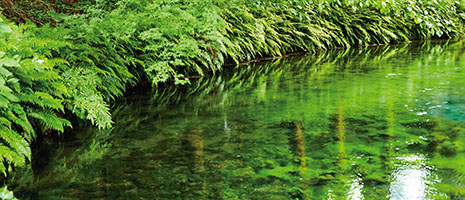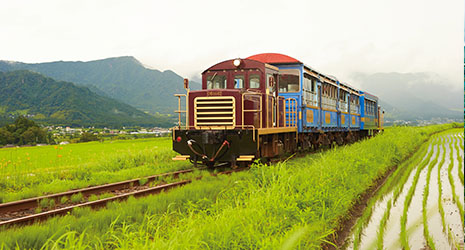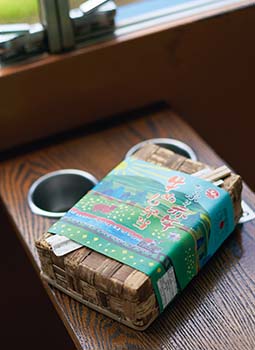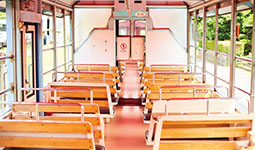Home > Highlighting JAPAN > Highlighting Japan July 2018 >A Trip by Local Train
Highlighting JAPAN


- PREVIOUS
- NEXT
A Train That Conveys the Spirit of Recovery
A journey on Minami Aso Railway’s trolley train, which trundles past the Aso Caldera—one of the world’s largest volcanic craters—gives riders the leisurely opportunity to marvel at the natural splendors of Kumamoto’s landscape.
The Minami Aso Railway ordinarily operates on a 17.7-kilometer-long track from Takamori Station to Tateno Station, where it connects with the JR Hohi Line that extends all the way to the city of Kumamoto. The line suffered extensive damage in the earthquake that shook Kumamoto in April 2016, however, and currently only runs 7.1 kilometers, with five stops between Takamori and Nakamatsu stations. They aim to have the whole line back in service by the end of March 2022.
From March to November, the railway runs a trolley train twice a day on weekends, public holidays, the spring and summer holidays, and during Golden Week1. Visitors come from all over Japan and overseas to ride these trolleys. On board, you’ll find retro electric fans and lamps—original equipment dating back to the days of the national railway2, when the trolleys were used as freight trains—that evoke a nostalgic atmosphere. The windows slide open, and when the weather is nice you can open them completely to take in Minami Aso’s fresh air during the trip, which is 25 minutes each way.
The scenery is magnificent, and the most impressive sight are the five peaks that make up Mount Aso. Seen from afar, this mountain range resembles the silhouette of an enormous Buddha lying in repose, so it is also known as the “Statue of the Buddha in Nirvana.” Rice paddies and vegetable fields cover the surrounding terrain in vibrant shades of green.
The maximum speed of the trolley is forty kilometers per hour, which is far slower than an ordinary train. When the train nears one of the many interesting spots that dot the landscape of the Minami Aso region, such as the headwaters of rivers, it slows to a walking pace. As a result, you get to experience the fluttering of butterflies, chirping of birds, and scent of plants that you would otherwise miss.
It’s also nice that people walking down the roads or working in the fields will almost always stop to wave as the train passes by. When they do, people on board instinctively wave back, and smiles ripple throughout the train. Hideaki Yamamoto of the Minami Aso Railway says, “The locals started to wave spontaneously. I believe it’s a manifestation of their support of the railway and their desire to see the track fully reopened.”
The conductor’s commentary is another highlight. They jovially tell passengers about the formation of Aso’s five mountains, the history of the Minami Aso region, and provide sightseeing and local food recommendations. Audio guides in English, Korean and Taiwanese are available for visitors from overseas.
The stations along the way have their own charms. For instance, Minamiaso-Shirakawasuigen Station is the closest stop to the source of the Shirakawa, a river that flows at a rate of sixty tons of water per minute. Minami Aso has so many water sources that it is sometimes called “the birthplace of water,” and the Shirakawa’s source is particularly renowned—selected as one of the 100 Remarkable Waters in Japan by the Ministry of the Environment—and many people come to sample its waters.
Another highlight is a bento box offered at the station that features local Akaushi beef stewed in ginger and soy sauce. Nakamatsu Station is famous for the toy collection on display, which was assembled by the owner of the café inside the station building. The coffee there is made with local spring water, and is the perfect way to relax. There’s also a giant cherry blossom tree in Isshingyo Park—just a fifteen-minute walk from the station—that’s four centuries old.
Even along the section of track currently closed (between Nalamatsu and Tateno stations), the Minami Aso Railway has so much to offer, including hot springs and bridges with spectacular views of nearby valleys. The train will continue to trundle along as rail fans and locals eagerly await the day in 2022 when the whole track is operational again.
*1 Golden Week: a period of national holidays that stretches from late April to early May.
*2 National Railway: The Japanese National Railway (JNR) was the name for the railway when it was run by the government. The JNR was broken up and privatized in 1987, and is now operated by the JR Group.
- PREVIOUS
- NEXT
© 2009 Cabinet Office, Government of Japan








